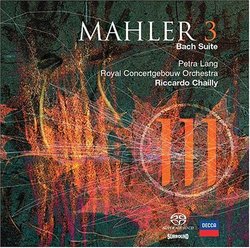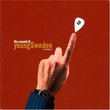| All Artists: Gustav Mahler, Riccardo Chailly, Annelie de Man, Petra Lang, Royal Concertgebouw Orchestra, Richard Ram Title: Mahler 3: Bach Suite Members Wishing: 0 Total Copies: 0 Label: Decca Release Date: 6/15/2004 Album Type: Hybrid SACD - DSD Genre: Classical Style: Symphonies Number of Discs: 2 SwapaCD Credits: 2 UPC: 028947065227 |
Search - Gustav Mahler, Riccardo Chailly, Annelie de Man :: Mahler 3: Bach Suite
 | Gustav Mahler, Riccardo Chailly, Annelie de Man Mahler 3: Bach Suite Genre: Classical No Description Available No Track Information Available Media Type: SACD Artist: MAHLER,G. Title: SYM 3 Street Release Date: 06/15/2004 |
Larger Image |
CD DetailsSynopsis
Product Description No Description Available No Track Information Available Media Type: SACD Artist: MAHLER,G. Title: SYM 3 Street Release Date: 06/15/2004 Similar CDs
|
CD ReviewsBest Mahler 3 on SACD peteyspambucket | New York, NY | 11/18/2004 (5 out of 5 stars) "Move to the head of the class. The performance here by Chailly and the RCOA overshadows recent SACDs from Boulez, MTT, and Zander. This is the real deal. FINALLY! Everything is so carefully thought out in this performance, and the playing is highly idiomatic. The bass drum will have cups moving on your coffee tables. Certain parts of the interpretation are exactly as called for in the score, and I am so thrilled that they were caught so vividly on this SACD. These are orchestral effects like glissandos, mutes, brass trills, dynamic effects, "Schalltrichter in die Hoehe" or "Schalltricther auf" (really comes through!!!!!), etc. The brass are very nicely captured. The winds come out like a nice wind choir. The orchestral quality is very European and balanced with a lot of transparency, which is not typical of American orchestras and these days, even the VPO and the BPO don't have this quality very much any more. This has been so well recorded, that you will really be able to hear every part, just like you can in a concert hall. In the 4th Movement, Petra Lang does a very nice job in her song, and the brass and bassoons have a wonderful ominous sound. In the 5th Movement, the women's chorus is very well captured and it moves along very nicely with wonderful energy. The last movement, the jewel of the symphony (next to the first movement), is ravishing. You will not want it to end. The quiet sections are so lovingly shaped and filled with yearning. You can hear the vibrato of individual violin players at times. The dramatic and bitter utterances are very jarring and then soothed by the main theme with great sensitivity and Chailly gives the transitions a lot of space. The final chorale builds to a very satisfying climax. Chailly holds out the final note of the symphony just like Mahler wanted (a fermata, and with notations to not allow the sound to diminish at all, and not to have an abrupt release) and the effect is beautiful. At 22min, the final movement is, timing-wise, faster than most, but it has great lyrical weight and speaks very much in that time. I'm thrilled about this performance and this SACD! Although Chailly's Mahler cycle hasn't always had such great performances (the 8th, despite an awesome cast, was a huge disappointment), this one is really an achievement. If you don't know this piece, this performance will be an excellent introduction; and if you don't know Mahler very well, or have been a Mahler-naysayer, give this one a shot, because this is Mahler done "right". Up next, the 9th, and Chailly's cycle will be complete. HIGHLY RECOMMENDED without reservation. It's also priced much cheaper than the competition (and it's own Redbook-only version) so not only is it a great performance, it's a bargain, too." Chailly, RCGBO & Mahler: Finally, the heights (sound+perfor) Dan Fee | Berkeley, CA USA | 07/04/2004 (5 out of 5 stars) "Finally. I have had considerable doubts about many of the previous recordings in this ongoing Mahler complete symphony series. Often, to me and my ears, Chailly sounds like he is glossing over, and sometimes even compressing or truncating, many of the many specific expressive indications that Mahler took great pains to write into his scores. The foreshortening of dynamic ranges, for example, often bothers me quite a bit. Mahler is famous for writing extremes into his phrasing, ranging from triple or quadruple soft (pppp) to triple or quadruple forte/loud (ffff). While this can be easily dismissed by carelessness on the conductor's part, or by the inabilities of a given band to carry the range as indicated; the fact is, if Mahler is going to express himself, he needs careful and scrupulous observance of his markings. This is particularly true when such detailed dynamics as are marked are cross-happening throughout different departments of the huge orchestra. Mahler knew what he wanted musicians to play, and as a conductor he had decades of experience with high-level bands that he usually left playing at an even higher level. If you observe the markings, in my view, you can get away with quite a few other variations in your approach, including tempo. Some Andante movements are slower or faster than others, but nonetheless express genuine Mahlerian style and narration.In the past recordings, these are the points where I have felt let down by Chailly. The Concertgebouw has a fabulous and honestly-earned Mahler tradition, dating all the way to Willem Mengelberg and Otto Klemperer. And as regards the Haitink-led versions, I think the orchestra mostly carried the conductor to whatever success he achieved in those recordings. With Chailly, however, it often seemed to me that he was overriding the orchestra's knowledge of how exacting Mahler might sound, in favor of a sort of operatic, generalized interpretation.Well, no more. In this one, Chailly has finally allowed himself to settle into the deep and abiding performance practices of the Mahler traditions that this world-class orchestra has long embodied. He does contribute something to their understanding, in the way of a certain operatic and songful flow. But in this case, his operatic sensitivities do not preclude being much more faithful to observe Mahler's myriad expressive markings. The success of this performance also includes a clarity of the polyphony .... whether chamber-like in texture, or grand full orchestra ... that is indispensable in great Mahler.The soloist Petra Lang carries the Nietzsche movement off at a high level of vocal and interpretive insight. It is a difficult thing to sing this night-music, I imagine. First of all, you are almost completely exposed as a singer, and if you do not have the vocal resources to manage, or you do not know how to marshal your voice to the expressive line, your lack is obvious to all listeners. Secondly, although Mahler writes wonderful music for his Wunderhorn songs, they cross over to instrumental phrasing and expression, as the orchestra plays with you. Petra Lang continues her artistry in the next movement, joined by the children's chorus and the women. All are exquisitely bell-like and raucous, managing to suggest a rather lively and country-wided view of heaven and its redemption of humankind as common folk, not nobility.Then the orchestra takes over in the famous culmination of the final movement. With string tone that must be the envy of many a player in big-name orchestras all over the world, the RCGBO puts us on immediate notice that this last movement of the Third Symphony will be the mystical fulfillment of Mahler's comprehensive vision. ("The symphony must be a whole world," Mahler said.) Each instrumental department gradually joins in, as Mahler expertly weaves and interweaves materials from prior movements, at the same time demonstrating so joyously to the human ear how masterfully he could transform what (at first hearing) appear only to be innocuous and mischievous folk themes.My measure of the Third Symphony has long been the revered recording by Jascha Horenstein with the London Symphony Orchestra. I almost never find other versions its full equal, although I have added Boulez, Solti, Abbado, Neumann, and Bertini to the nearby shelf. Now, I believe a very close second has arrived. Chailly still cannot match the dark, malevolent detail of the Jascha Horenstein; but he matches its overall grandeur of musical vision, at last successfully bringing his songful ear to the rich and pervasive Mahlerian genius of this great orchestra. If only earlier recordings of other symphonies had been so blessed as is this one.No one who listens to this recording can fail to mention the SACD high resolution surround sound. Perhaps those other, earlier Chailly versions of Mahler symphonies are lacking, because they are not yet available via this incredible, vivid sound. More successfully than it is possible to describe, you are placed in the Grotesaal of the Amsterdam home of these wonderful players. The sheer tonal presence of their genius is captured and recreated by the quality of recording. A giant coup is delivered in the surround sound mix, neither too close nor too distant. You can tangibly sense the hall without being bombarded by echoes and reflections that interfere with paying attention to the main event of the RCGBO playing in front of you.Very highly recommended, SACD version. This will be one of the demo discs in lots of equipment rooms, unless I am very mistaken. Five stars, counted very slowly at twilight on a very good day." Best overall Mahler 3rd of any B. Guerrero | 12/27/2006 (5 out of 5 stars) "If, like me, you consider a recording of something as huge and all encompassing as Mahler's 3rd to always be something of a compromise - a gesamtkunstwerk of conducting, orchestral execution, singing, and sound quality - then you might come to the same conclusion as I: this is the best overall M3 to date. Yes, there are things that could have been just a tad better - the mezzo being one of them (Petra Lang). But you won't hear better or more detailed accompaniment underneath the mezzo either. In fact, I've never heard an M3 where what the mezzo was doing, and what the orchestra was doing, was so well integrated as here. Maybe that's because Decca's fine recording quality brings things into sharper perspective, I don't know. Also, the coda to the third movement (scherzo) could be a bit more grand in scope. But everything else about the scherzo is darn near perfect, including the distance and pacing of the offstage trumpet solos - the so-called "posthorn". Just listen to how fabulous the Concertgebouw woodwinds sound at the start of the scherzo - it doesn't get any better than this. Chailly's first movement is a huge tour-de-force, capturing just a collosal amount of dynamic range and orchestral detail. Nope, there's no need to hype this recording - the evidence is all there. All six movements are really well done, which is rare. In the finale, Chailly progressively lengthens each of the symphony's final three chords. That's such an obvious thing to do! - why hasn't anyone thought to do that before? Yep, it's not perfect. As always, some minor details could still be better yet. But I also can't think of any other recording that gets so little "wrong" (nothing, really), and so much right. If you're going to get this, regardless of how you're playing it back, get it in the DSD upgrade, which is the SACD/CD hybrid version, . Decca has priced it the same as the regular version.
" |




